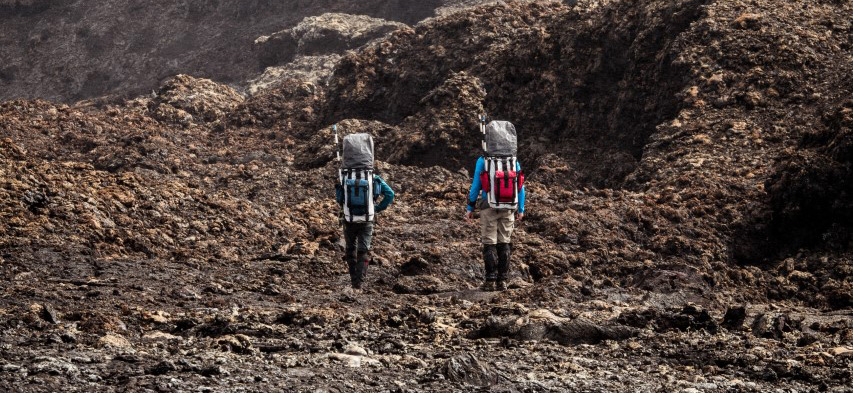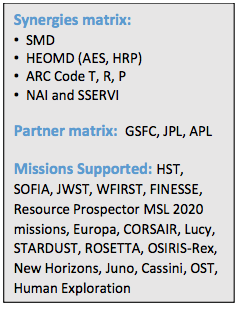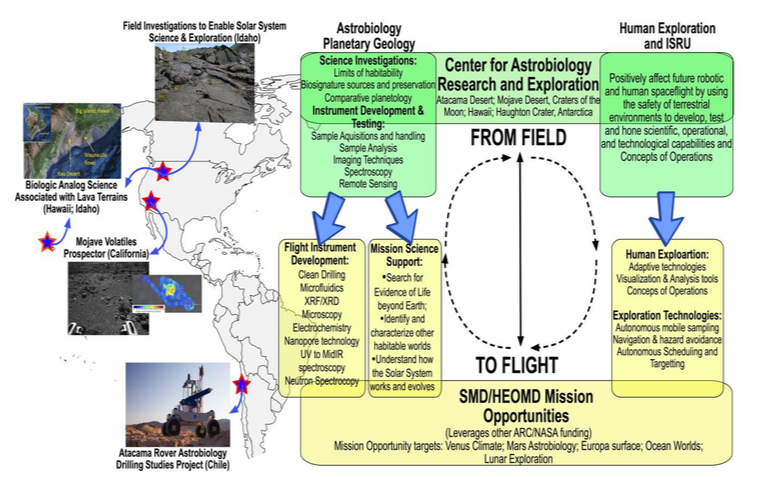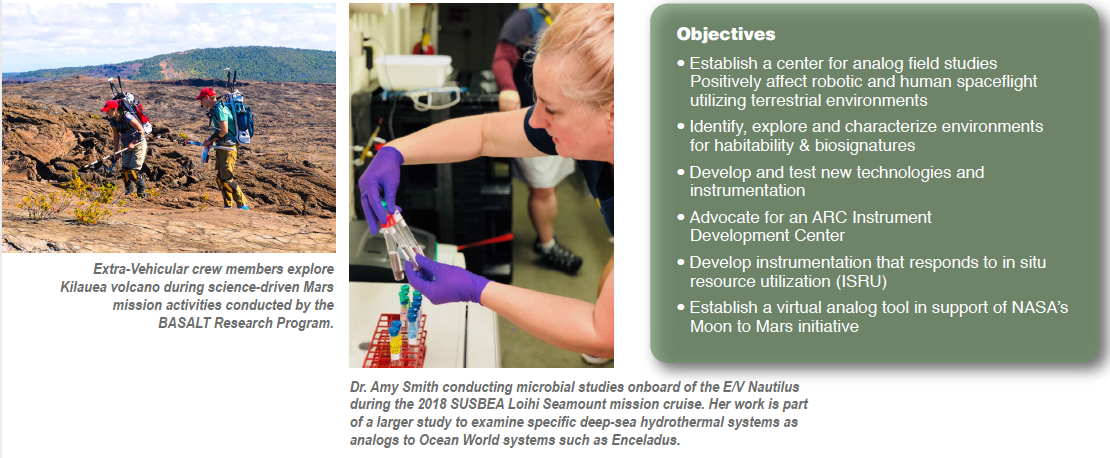Impact & Benefits
Core Capability 6 – Analog Research & Instrument Development
Analog Research & Instrument Development Highlights
Fieldwork
The Agency core capability for Analog Research and Instrument Development will continue to lead innovation, mission design concepts for operations, and perform field tests in analog environments using low-cost, prototype instrumentation. The Instrument Development component will develop instruments for flight missions in the areas of life detection, planetary mineralogy, and geochemistry, in situ atmospherics, and in situ resource identification and utilization. The teams’ expertise, in partnership with other NASA Centers, will be focused on providing Agency leadership in science-driven robotic and human exploration missions as well as small mission instrumentation concepts.
This Analog Research core capability will advance science instrumentation from low to mid Technology Readiness Levels (TRL), preparing them for flight maturation through testing in relevant environments (for example, in vacuum over the range of temps encountered on the Moon, or at Mars surface pressures over the temp range found there), and then for mission insertion. Additionally, we will improve the Agency’s Core Competency science expertise in Life Detection, Planetary Geology, and Geochemistry, and expand on in-situ atmospheric measurements across SMD interests and leverage collaboration with STMD and HEOMD as well.
The Division capability for Analog Research will continue to focus on the following three science areas:
(1) Exploration of new environments, selected on the basis of habitability and biosignature parameters;
(2) Geologic investigations for understanding planetary systems; (3) Analog field work in support of human and robotic exploration; and will add a fourth area in 2019 that will focus on the creation of virtual, “Synthetic Worlds”, in collaboration w/Code TI, based on analog data, to be used for planetary mission design and operations. Figure 6.1 is a summary of select on-going analog field sites, flight Instrument development, and mission science supported programs, highlighting the Division expertise available to the Agency.
Additionally, these science capabilities and mission concepts will be applied to potential mission analog field sites and a variety of spacecraft platform opportunities, including balloons and small satellites, in order to perform planning and ground truthing of mission and instrument concept operations for future robotic and exploration missions.
Based on ARC heritage and current facilities, this core competency will capitalize on in-house capabilities to bring expertise to the Agency in the following areas:
- Exobiology /Life Detection Extremophile Laboratories
- Life Detection and Planetary Protection Protocol Development Instrument Assembly
- IR Astrophysics Laboratories & Astrochemistry Laboratories
- XRD/XRF Instrumentation Laboratories
- Optical/NIR/MIR imaging technologies
- Intelligent Systems
- In situ atmospherics and resource identification and utilization
- Fabrication Machining, Measurement, and Engineering Evaluation Laboratories
- Environmental Chambers
- Planetary Geology Laboratory & Field Instrumentation
- Ocean Worlds science and exploration
Analog field-based research activities provide a lower risk and lower cost environment within which to test and refine protocols and procedures for both robotic and human planetary exploration. Within these analog settings, researchers can develop and iterate on Concepts of Operations (operational design elements that guide the organization and flow of hardware, personnel, communications, and data products through the course of a mission implementation) and supporting Capabilities (functionalities that can take the form of hardware or software) that are focused on optimizing both science return and exploration. This analog testing approach helps to increase the efficiency and efficacy of robotic and human exploration throughout the Solar System.
Objective 6.1 – Establish a Center for Analog Field Studies
Across the Agency, scientists are interested in identifying, exploring and characterizing environments for habitability and biosignatures. This is true for planetary science and astrophysics, connecting planets in our solar system with those detected orbiting alien suns. Our own solar system, which we can visit and study in detail, allows geologic investigations to understand evolution and serve as a proxy for exoplanets. Robotic and human exploration is a major goal of NASA, and the ARC analog team will maintain its leadership in analog field work to support and enhance this goal.
Objective 6.2 – Positively Affect Robotic and Human Spaceflight Utilizing Terrestrial Environments
Future robotic and human spaceflight and exploration will be positively affected by using the safety and convenience of terrestrial environments to develop, test, and hone scientific, operational, and technological capabilities. Concepts of operations that will best serve NASA’s core vision and the community. Ames currently has a large cadre of field instrumentation to enable high-fidelity science- driven deployments. Analog testing of such instruments by humans or with robotic rovers and mechanisms can help demonstrate and improve concepts of operations for flight missions. The lessons learned can then be directly applied to future missions such as Resource Prospector or NASA and commercial landed missions to the Moon as well as other planetary bodies.
Objective 6.3 – Identify, Explore and Characterize Environments for Habitability & Biosignatures
Extreme environments on Earth are often proxies allowing the pursuit of information related to habitability and searching for signs of life. Astrobiology field research will continue to be held in extremely dry (hot and cold) environments as analogs to Mars (for example Earth analog volcanic craters and lava tube environments and dry desert regions around the world). Ocean worlds offer a promising habitable environment within hydrothermal systems as well. An ARC science team has begun leading analog exploration research, in connection with NOAA, focused on fluid venting at isolated seamounts in the deep ocean. The future promises to expand knowledge of possible habitable niches across the solar system and beyond.
Objective 6.4 – Develop and Test New Technologies and Instrumentation
Ames scientists are building, testing, and producing new, innovative science instrumentation and technology to support NASA’s current and future space mission objectives. In both astrophysics and planetary science, we are particularly involved in exoplanet characterization and next generation planetary missions to the Moon, Mars, asteroids, as well as Europa & Enceladus. Analog mission testing has benefited from new instrument developments and studies, including ARADS and BASALT. The Resource Prospector mission has benefited from analog deployment of engineering model instruments in a field setting, reducing operational risk and increasing operational efficiency. It is expected that these direct benefits will continue to be important in both robotic and human exploration mission concepts.
Objective 6.5 – Advocate for an ARC Instrument Incubator Development Center
This instrument development center (IDC) would be similar to the Mission Design Center (MDC) and will fold in science, engineering and project management expertise (with Codes R and P). For example, as NASA gives increased emphasis to lunar return, opportunities for both new missions and new instrument technologies will become available. It is critical to underpinning emerging mission and instrument concepts with an appropriate level of engineering support to be successful, from concept, through design, and into flight development. The development center would provide:
- IDC reports to Executive Council weekly – inform/educate leadership
- Resources for engineering support for low to mid-TRL instrument development stages
- Internal peer review of instrument and mission proposals
- A repository of documentation for past successful projects
- Promotion of cross-center project collaboration
Objective 6.6 – Develop Instrumentation That Responds to In-situ Resource Utilization (ISRU)
By aligning with and supporting HEOMD, AES, SMD, and STMD goals and objectives, we plan to formulate new technology that advances ISRU at the Moon, asteroids, and Mars. Resource Prospector is the first landed lunar mission focused entirely on ISRU at the Moon, specifically polar volatile deposits that may offer a sea change in how Exploration is carried out. NASA’s new Public-Private Partnership for lunar landed services will open the door to non-governmental entities actually exploring ISRU feasibility and other commercial uses of lunar resources. We also are developing and testing IRRU for ocean worlds such as Europa. Such instruments will be used for characterizing the composition, structure, dynamics, and aerosols on/within/near solid body surfaces and atmospheres. Cutting edge instrumentation will continue to be developed in order to be ready for missions to the atmospheres of Venus, Mars, Titan and the giant planets.
Objective 6.7 – Establish a ‘virtual analog tool’ in support of NASA’s Moon to Mars initiative
In support of NASA’s new “Moon to Mars” initiative, we plan to implement a “virtual analog tool” for testing mission operations concepts. In conjunction with Code TI, under the Resource Prospector mission auspices, Analog TT members have built a synthetic lunar world using real lunar topography, lighting, and optical phase functions, with realistic soil mechanics and surface features including impact craters of all sizes as well as rocks down to centimeter scales (see figure, left). We integrated rover-borne instrument models so that scientists can see virtual data, and mission operators can gauge the effects of real-time discovery, and resulting feedback on mission traverse plans. While the Mars program has created similar capabilities, Ames’ virtual lunar surface is the most realistic for lunar surface robotic operations.
While this facility was created by and for the now-canceled Resource Prospector mission, the existing tools continue to offer significant potential for developing landed surface robotic operations on the Moon. Whether for a near-term Commercial Lunar Payload Services opportunity, or a larger mid-term mobile robotic mission for science and/or ISRU, a virtual analog can offer significant, rapid evolution of robotic mission concepts of operations, and actual procedure development. With suitable models of spacecraft/rover battery power management, and realistic surface activity energy needs and durations, this tool can provide quantitative feedback to mission system engineers, as well as mission operations developers. A key issue, as with the other analogs research areas, is continued support. Because this is a joint development with Code TI, ongoing resource needs would need to be coordinated at the Center level.































